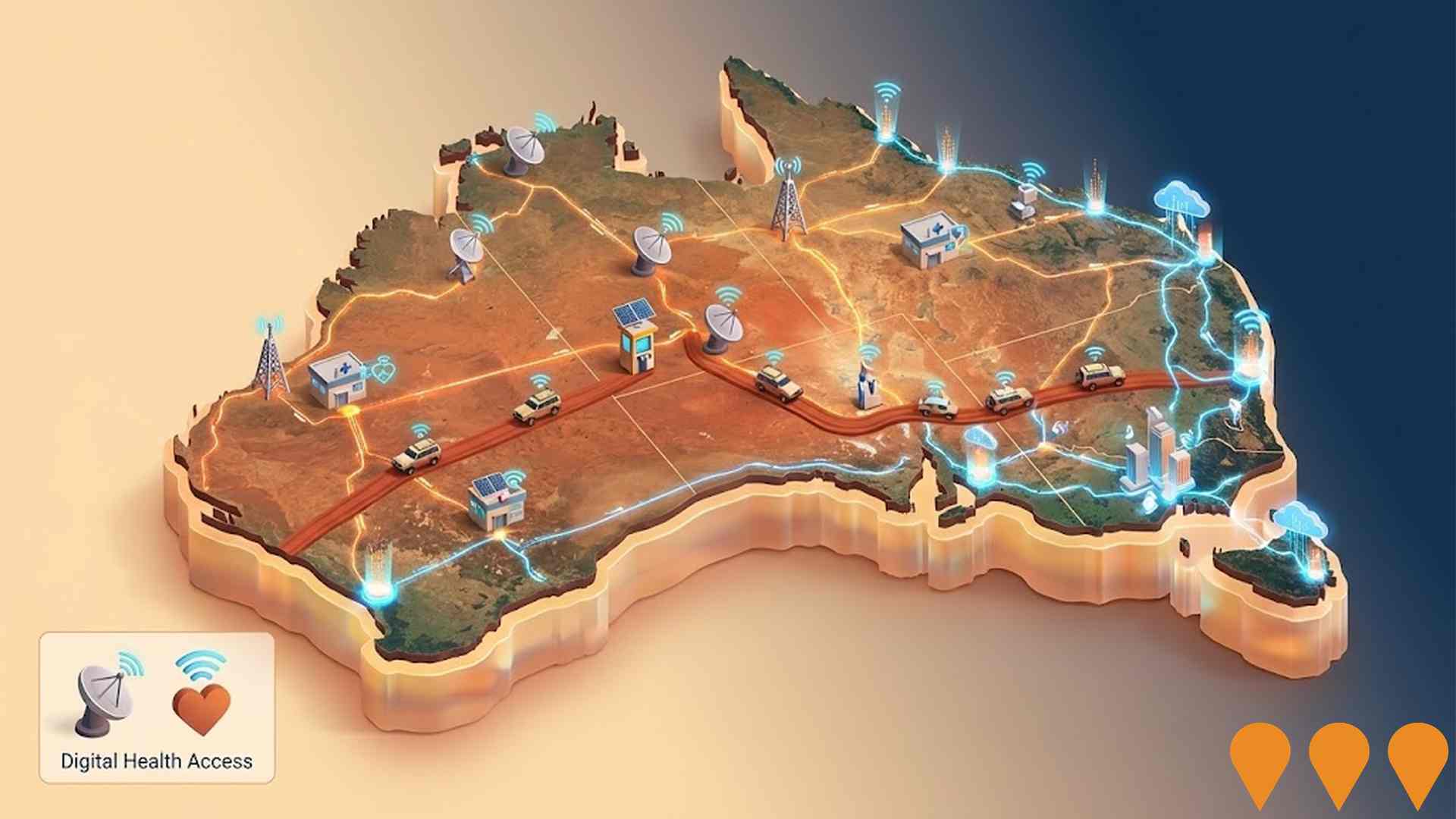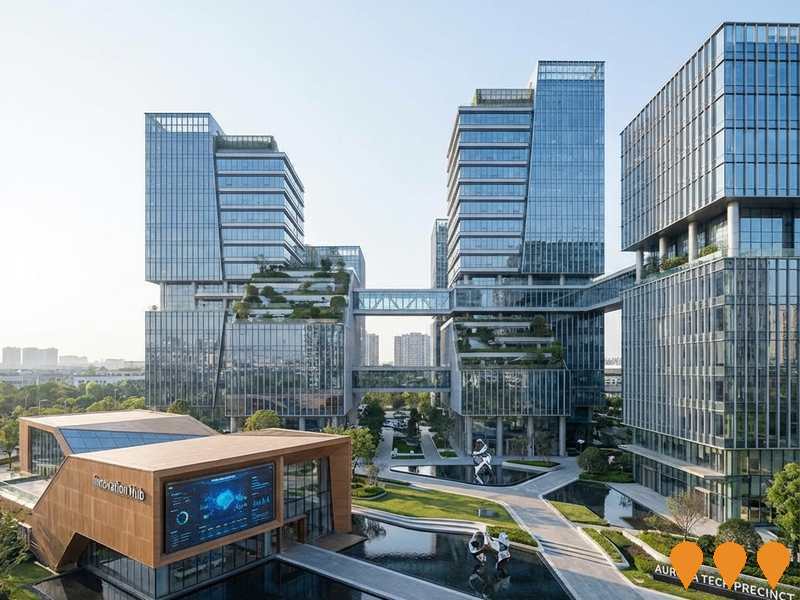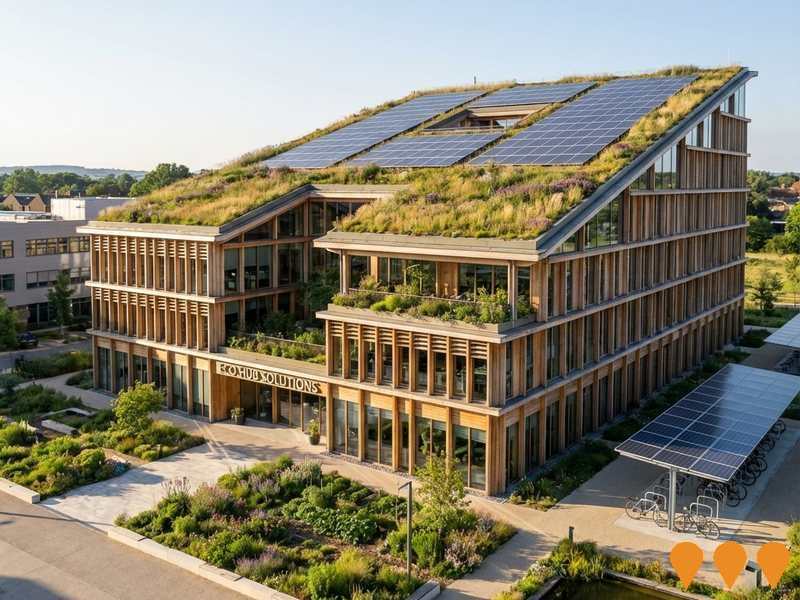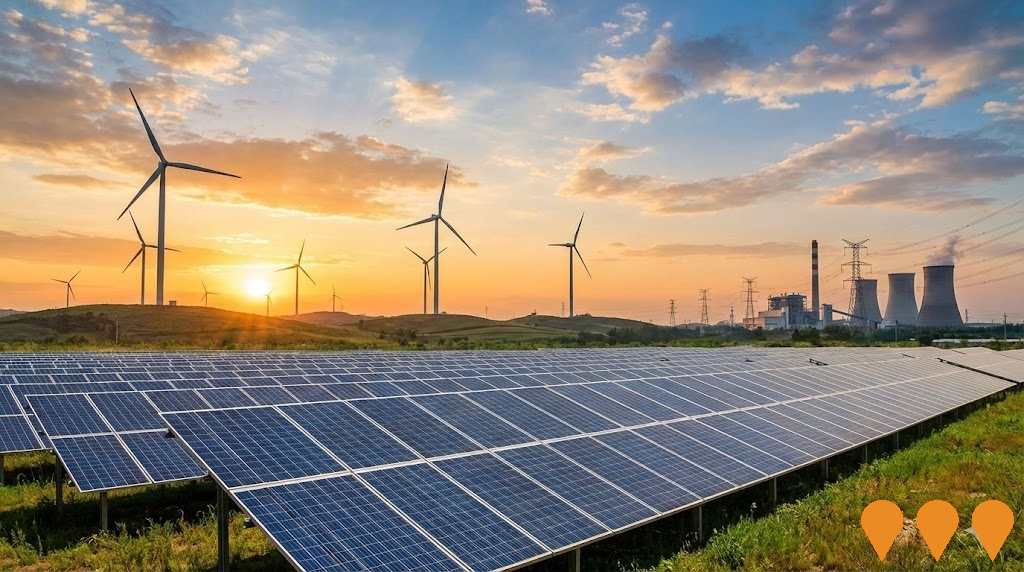Chart Color Schemes
est. as @ -- *
ABS ERP | -- people | --
2021 Census | -- people
Sales Activity
Curious about local property values? Filter the chart to assess the volume and appreciation (including resales) trends and regional comparisons, or scroll to the map below view this information at an individual property level.
Find a Recent Sale
Sales Detail
Population
Virginia has seen population growth performance typically on par with national averages when looking at short and medium term trends
Virginia's population was approximately 3,625 as of Aug 2025. This figure reflects an increase of 428 people since the 2021 Census, which reported a population of 3,197 people. The change is inferred from the estimated resident population of 3,598 from the ABS as of June 2024 and an additional 41 validated new addresses since the Census date. This equates to a density ratio of 66 persons per square kilometer. Virginia's growth rate of 13.4% since the 2021 census exceeded the national average of 8.6%. Population growth was primarily driven by natural growth, contributing approximately 40.7% of overall population gains during recent periods.
AreaSearch is adopting ABS/Geoscience Australia projections for each SA2 area, released in 2024 with a base year of 2022. For areas not covered by this data and post-2032 estimations, AreaSearch applies growth rates by age cohort provided by the ABS in its latest Greater Capital Region projections (released in 2023, based on 2022 data). Demographic trends forecast a significant population increase in top quartile statistical areas across the nation. The area is expected to grow by 947 persons to 2041, recording a gain of 25.4% over the 17 years.
Frequently Asked Questions - Population
Development
Residential development activity is slightly higher than average within Virginia when compared nationally
Virginia has seen approximately 15 new homes approved annually. Over the past five financial years, from FY-21 to FY-25, around 79 homes were approved, with an additional 7 approved so far in FY-26. Each dwelling built over this period attracted an average of 2.8 new residents per year, indicating strong demand that supports property values.
The average construction cost value for these new homes was $460,000. This financial year has also seen $2.5 million in commercial approvals, suggesting limited focus on commercial development. Compared to Greater Darwin, Virginia's construction activity is 30.0% higher per person over the past five years, offering more buyer choice while supporting current property values.
New developments consist of 92.0% standalone homes and 8.0% medium and high-density housing, maintaining the area's traditional low density character with a focus on family homes. With around 245 people per approval, Virginia reflects a transitioning market. Future projections estimate Virginia will add 920 residents by 2041. If current development rates continue, housing supply may not keep pace with population growth, potentially increasing competition among buyers and supporting stronger price growth.
Frequently Asked Questions - Development
Infrastructure
Virginia has limited levels of nearby infrastructure activity, ranking in the 2ndth percentile nationally
No changes can significantly affect a region's performance like alterations to local infrastructure, major projects, and planning initiatives. AreaSearch has identified zero projects that are predicted to impact this area. Notable projects include Darwin Light Rail Stage 1, Darwin Renewable Energy Hub, Hudson Creek Power Station, and Marine Industry Park. The following list details those expected to be most relevant.
Professional plan users can use the search below to filter and access additional projects.
INFRASTRUCTURE SEARCH
 Denotes AI-based impression for illustrative purposes only, not to be taken as definitive under any circumstances. Please follow links and conduct other investigations from the project's source for actual imagery. Developers and project owners wishing us to use original imagery please Contact Us and we will do so.
Denotes AI-based impression for illustrative purposes only, not to be taken as definitive under any circumstances. Please follow links and conduct other investigations from the project's source for actual imagery. Developers and project owners wishing us to use original imagery please Contact Us and we will do so.
Frequently Asked Questions - Infrastructure
Australia-Asia PowerLink (AAPowerLink)
The world's largest renewable energy infrastructure project, comprising a 17-20GW solar farm and 36-42GWh battery storage in the Barkly Region, connected via HVDC transmission to Darwin and Singapore. The project received Commonwealth environmental approval in August 2024. It aims to supply up to 4GW of green electricity to Darwin industrial customers and export power to Singapore.

Darwin Light Rail Stage 1
A proposed mass transit system, likely light rail or rapid bus, connecting Darwin CBD to Palmerston via the Stuart Highway corridor. The project aims to manage future population growth, reduce congestion, and improve connectivity between the two major population centres as part of the long-term Darwin Regional Transport Plan. While currently in the strategic planning phase with no immediate construction funding, the corridor has been identified for future preservation to support a '30-minute city' concept.

Enabling Digital Health Services for Regional and Remote Australia
National initiative to expand and improve digital health access for people in regional and remote Australia. Focus areas include enabling telehealth and virtual care, upgrading clinical systems and connectivity, supporting secure information exchange, and building workforce capability in digital health, aligned with the Australian Government's Digital Health Blueprint and Action Plan 2023-2033.

Desert Springs Octopus Renewable Energy Program
Majority Indigenous-owned developer pursuing a near-term pipeline of grid-connected solar and battery projects along the Darwin-Katherine Electricity System, with potential to expand into wind and green hydrogen. Partnership includes Octopus Australia with Larrakia Nation and Jawoyn Association to deliver utility-scale renewable energy and community benefit sharing.

National EV Charging Network (Highway Fast Charging)
Partnership between the Australian Government and NRMA to deliver a backbone EV fast charging network on national highways. Program funds and co-funds 117 DC fast charging sites at roughly 150 km intervals to connect all capital cities and regional routes, reducing range anxiety and supporting EV uptake.

Darwin Renewable Energy Hub
Northern Territory Government proposal to co-locate up to six utility-scale solar farms (total 180-210 MW) with a battery energy storage system on 940 ha of Crown Land west of Finn Road, feeding the Darwin-Katherine grid. Site identified for industry in regional land use plans; consultation held to February 28, 2025 and environmental assessment processes are underway.

Hudson Creek Power Station
12MW natural gas-fired power plant, NT's first privately owned grid-connected gas generation facility. Features 25% lower emissions than average NT gas generators. Part of dual project with Batchelor Solar Farm, creating 162 construction jobs and providing vital grid stability to Darwin-Katherine network.

Marine Industry Park
Marine and offshore industries servicing hub at East Arm, Darwin. Stage 1 planning approval is secured for a purpose-built industrial subdivision near the new Darwin Ship Lift, with expressions of interest open for serviced lots. Existing common-user facilities include an all-tide barge ramp (first point of entry) and a secure hardstand supporting storage and fabrication activities.

Employment
Employment conditions in Virginia demonstrate exceptional strength compared to most Australian markets
Virginia's workforce is skilled with well-represented essential services sectors. The unemployment rate in Virginia as of June 2025 was 2.1%.
Over the past year, there has been an estimated employment growth of 2.8%. As of this date, 2,128 residents are employed while the unemployment rate is 0.9% lower than Greater Darwin's rate of 3.0%. Workforce participation in Virginia is similar to Greater Darwin's at 69.7%. Employment among residents is concentrated in public administration & safety, construction, and retail trade.
Virginia has a particular employment specialization in construction, with an employment share 1.7 times the regional level. However, health care & social assistance has limited presence with only 8.6% employment compared to the regional average of 14.2%. The predominantly residential area appears to offer limited local employment opportunities, as indicated by the count of Census working population versus resident population. Over the 12 months to June 2025, employment increased by 2.8% while labour force increased by 2.9%, keeping the unemployment rate relatively stable. By comparison, Greater Darwin recorded employment growth of 2.9% with a marginal decrease in unemployment. Jobs and Skills Australia's national employment forecasts from May 2025 suggest that Virginia's employment could increase by approximately 5.9% over five years and 12.2% over ten years, based on simple weighting extrapolations for illustrative purposes.
Frequently Asked Questions - Employment
Income
Income metrics indicate excellent economic conditions, with the area achieving higher performance than 75% of national locations assessed by AreaSearch
Virginia's median income among taxpayers was $61,145 in financial year 2022. The average income stood at $71,059 during the same period. These figures are higher than those for Greater Darwin, which were $65,522 and $75,260 respectively. By September 2025, estimates based on a 12.01% Wage Price Index growth suggest median income could reach approximately $68,489 and average income could be around $79,593. According to Census 2021 data, incomes in Virginia rank highly nationally, with household, family, and personal incomes between the 75th and 86th percentiles. Income distribution shows that 31.4% of Virginia's population falls within the $1,500 - $2,999 income range, consistent with broader regional trends where 36.7% fall into the same category. A substantial proportion, 34.1%, earns above $3,000 per week, indicating strong economic capacity in the suburb. High housing costs consume 15.3% of income, but strong earnings place disposable income at the 76th percentile nationally. The area's SEIFA income ranking places it in the 6th decile.
Frequently Asked Questions - Income
Housing
Virginia is characterized by a predominantly suburban housing profile, with above-average rates of outright home ownership
In Virginia, as per the latest Census evaluation, 79.5% of dwellings were houses while 20.5% comprised semi-detached homes, apartments, and other types. This contrasts with Darwin metro's figures of 92.6% houses and 7.4% other dwellings. Home ownership in Virginia stood at 30.4%, similar to Darwin metro's rate, with mortgaged properties at 40.3% and rented ones at 29.3%. The median monthly mortgage repayment in Virginia was $2,383, higher than Darwin metro's average of $2,250. The median weekly rent figure in Virginia was recorded as $370, compared to Darwin metro's $380. Nationally, Virginia's mortgage repayments were significantly higher than the Australian average of $1,863, while rents were lower at $370 compared to the national figure of $375.
Frequently Asked Questions - Housing
Household Composition
Virginia features high concentrations of group households, with a lower-than-average median household size
Family households account for 74.0% of all households, including 32.6% couples with children, 29.3% couples without children, and 11.1% single parent families. Non-family households constitute the remaining 26.0%, with lone person households at 21.6% and group households comprising 4.2% of the total. The median household size is 2.7 people, which is smaller than the Greater Darwin average of 2.8.
Frequently Asked Questions - Households
Local Schools & Education
Educational attainment in Virginia aligns closely with national averages, showing typical qualification patterns and performance metrics
The area's university qualification rate is 17.4%, significantly lower than the SA4 region average of 31.3%. This disparity presents both a challenge and an opportunity for targeted educational initiatives. Bachelor degrees are the most common at 12.1%, followed by postgraduate qualifications (3.4%) and graduate diplomas (1.9%). Trade and technical skills are prominent, with 47.5% of residents aged 15+ holding vocational credentials – advanced diplomas (11.9%) and certificates (35.6%).
Educational participation is notably high at 31.5%, including 11.2% in primary education, 9.2% in secondary education, and 4.6% pursuing tertiary education. Virginia has 3 schools with a combined enrollment of 543 students, reflecting typical Australian school conditions (ICSEA: 985) with balanced educational opportunities. The educational mix includes 1 primary, 1 secondary, and 1 K-12 school. Note: where schools show 'n/a' for enrolments, please refer to the parent campus.
Frequently Asked Questions - Education
Schools Detail
Nearby Services & Amenities
Transport
Transport servicing is good compared to other areas nationally based on assessment of service frequency, route connectivity and accessibility
Transport analysis shows 33 active stops operating in Virginia, offering mixed bus services. These stops are covered by 50 routes, serving 3,825 weekly passenger trips. Transport access is rated limited with residents typically located 816 meters from nearest stop.
Service frequency averages 546 daily trips across all routes, equating to around 115 weekly trips per individual stop.
Frequently Asked Questions - Transport
Transport Stops Detail
Health
Virginia's residents are extremely healthy with both young and old age cohorts seeing low prevalence of common health conditions
Analysis of health metrics shows strong performance throughout Virginia with both young and old age cohorts seeing low prevalence of common health conditions.
The rate of private health cover was found to be very high at approximately 55% of the total population (~1,993 people). The most common medical conditions were asthma and arthritis, impacting 7.1 and 6.9% of residents respectively, while 73.0% declared themselves completely clear of medical ailments compared to 74.8% across Greater Darwin. Virginia has 16.8% of residents aged 65 and over (609 people), which is higher than the 13.9% in Greater Darwin. Health outcomes among seniors are particularly strong, performing even better than the general population in health metrics.
Frequently Asked Questions - Health
Cultural Diversity
Virginia ranks below the Australian average when compared to other local markets across a number of language and cultural background related metrics
Virginia's cultural diversity was found to be below average, with 85.1% of its population being citizens, 82.3% born in Australia, and 91.7% speaking English only at home. Christianity is the main religion in Virginia, comprising 38.6% of people. However, Buddhism is overrepresented compared to Greater Darwin, making up 1.5% versus 2.2%.
The top three ancestry groups are Australian (30.8%), English (28.1%), and Irish (7.2%). Notably, Australian Aboriginal (5.0%), New Zealand (0.8%), and Filipino (1.5%) ethnicities have higher representation in Virginia compared to regional averages of 5.8%, 0.7%, and 0.9% respectively.
Frequently Asked Questions - Diversity
Age
Virginia's median age exceeds the national pattern
Virginia's median age of 41 exceeds Greater Darwin's average of 34 and is slightly higher than Australia's median of 38. Compared to Greater Darwin, Virginia has a higher proportion of residents aged 55-64 (14.8%) but fewer residents aged 25-34 (12.2%). Between the 2021 Census and present, the 75-84 age group has increased from 3.6% to 4.8%, while the 35-44 cohort has risen from 12.0% to 13.1%. Conversely, the 45-54 cohort has decreased from 15.7% to 13.6% and the 25-34 group has fallen from 13.5% to 12.2%. By 2041, Virginia's age composition is expected to change significantly, with the 45-54 cohort projected to grow by 41%, reaching 693 from 492.




